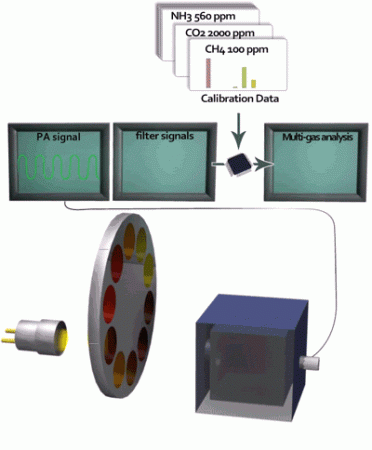Optical Filter Photoacoustic Spectroscopy
Photoacoustic spectroscopy (PAS) is based on the absorption of modulated infrared light leading to the local warming of the absorbing gas volume element. The generated pressure waves are detected by a pressure detector (i.e. microphone) producing signal proportional to the absorption.
Conventional photoacoustic infrared spectroscopy with mechanical chopper and optical filters

In conventional photoacoustic spectroscopy (PAS) setup the gas to be analyzed is sealed into a measurement chamber and irradiated by a modulated light of a pre-selected wavelength. The infrared radiation is focused with a mirror onto the window of the photoacoustic measurement chamber after it has passed a light chopper and an optical filter. The optical filter is typically a narrow-band infrared interference filter, which is selected by the absorption band of the target gas. More light will be absorbed if the concentration of the target gas is higher in the measurement chamber.
Photoacoustic infrared spectroscopy for multi-gas analysis
For simultaneous analysis of multiple gas compounds in a complex gas mixture, a set of optical filters is installed in a filter wheel. High selectivity is achieved by choosing several different filters with narrow spectral bands for target gases as well as for interfering gases. The analysis is based on least squares fit of the optical filter response data to the calibration data of pure gas compounds.

A mathematical model based non-linearity compensation is applied to all filter responses which expands the linearity range to over 100 000 times the detection limit using only one point span calibration!


















